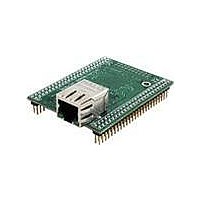MOD5234-100IR NetBurner Inc, MOD5234-100IR Datasheet - Page 686

MOD5234-100IR
Manufacturer Part Number
MOD5234-100IR
Description
MOD5234 10/100 ETHERNET MODULE
Manufacturer
NetBurner Inc
Type
Controllers & Processorsr
Datasheets
1.MOD5272-100IR.pdf
(3 pages)
2.MOD5234-100IR.pdf
(4 pages)
3.MOD5234-100IR.pdf
(754 pages)
Specifications of MOD5234-100IR
Interface
I²C, SPI, UART
Voltage - Supply
2.5V
Mounting Type
Surface Mount
Package / Case
Module
Product
Modules
Lead Free Status / RoHS Status
Lead free / RoHS Compliant
Data Format
-
Baud Rates
-
Lead Free Status / Rohs Status
Lead free / RoHS Compliant
Other names
Q4483564
- Current page: 686 of 754
- Download datasheet (13Mb)
Debug Support
The breakpoint status is also posted in the CSR. Note that CSR[BSTAT] is cleared by a CSR read
when either a level-2 breakpoint is triggered or a level-1 breakpoint is triggered and a level-2
breakpoint is not enabled. Status is also cleared by writing to TDR.
BDM instructions use the appropriate registers to load and configure breakpoints. As the system
operates, a breakpoint trigger generates the response defined in TDR.
PC breakpoints are treated in a precise manner—exception recognition and processing are initiated
before the excepting instruction is executed. All other breakpoint events are recognized on the
processor’s local bus, but are made pending to the processor and sampled like other interrupt
conditions. As a result, these interrupts are imprecise.
In systems that tolerate the processor being halted, a BDM-entry can be used. With
TDR[TRC] = 01, a breakpoint trigger causes the core to halt (PST = 0xF).
If the processor core cannot be halted, the debug interrupt can be used. With this configuration,
TDR[TRC] = 10, the breakpoint trigger becomes a debug interrupt to the processor, which is
treated higher than the nonmaskable level-7 interrupt request. As with all interrupts, it is made
pending until the processor reaches a sample point, which occurs once per instruction. Again, the
hardware forces the PC breakpoint to occur before the targeted instruction executes. This is
possible because the PC breakpoint is enabled when interrupt sampling occurs. For address and
data breakpoints, reporting is considered imprecise because several instructions may execute after
the triggering address or data is detected.
As soon as the debug interrupt is recognized, the processor aborts execution and initiates exception
processing. This event is signaled externally by the assertion of a unique PST value (PST = 0xD)
for multiple cycles. The core enters emulator mode when exception processing begins. After the
standard 8-byte exception stack is created, the processor fetches a unique exception vector, 12,
from the vector table.
Execution continues at the instruction address in the vector corresponding to the breakpoint
triggered. All interrupts are ignored while the processor is in emulator mode. The debug interrupt
handler can use supervisor instructions to save the necessary context such as the state of all
program-visible registers into a reserved memory area.
When debug interrupt operations complete, the RTE instruction executes and the processor exits
emulator mode. After the debug interrupt handler completes execution, the external development
system can use BDM commands to read the reserved memory locations.
If a hardware breakpoint such as a PC trigger is left unmodified by the debug interrupt service
routine, another debug interrupt is generated after the completion of the RTE instruction.
32.6.1.1 Emulator Mode
Emulator mode is used to facilitate non-intrusive emulator functionality. This mode can be entered
in three different ways:
MCF5235 Reference Manual, Rev. 2
32-42
Freescale Semiconductor
Related parts for MOD5234-100IR
Image
Part Number
Description
Manufacturer
Datasheet
Request
R

Part Number:
Description:
MCU, MPU & DSP Development Tools MOD5234 MODULE
Manufacturer:
NetBurner Inc
Datasheet:

Part Number:
Description:
MCU, MPU & DSP Development Tools MOD5234 Core Module Development Kit
Manufacturer:
NetBurner Inc
Datasheet:

Part Number:
Description:
BOARD SERIAL-ETHERNET 512K FLASH
Manufacturer:
NetBurner Inc
Datasheet:

Part Number:
Description:
PROCESSOR MODULE FLASH MOD5272
Manufacturer:
NetBurner Inc
Datasheet:

Part Number:
Description:
PROCESSOR MODULE 512KB FLASH
Manufacturer:
NetBurner Inc
Datasheet:

Part Number:
Description:
DUAL PORT SERIAL-ETHERNET
Manufacturer:
NetBurner Inc
Datasheet:

Part Number:
Description:
PROCESSOR MODULE FLASH
Manufacturer:
NetBurner Inc
Datasheet:

Part Number:
Description:
PROCESSOR MODULE 512KB FLASH
Manufacturer:
NetBurner Inc
Datasheet:

Part Number:
Description:
KIT DEVELOP NETWORK FOR MOD5282
Manufacturer:
NetBurner Inc
Datasheet:

Part Number:
Description:
KIT DEVELOP NETWORK FOR MOD5272
Manufacturer:
NetBurner Inc
Datasheet:

Part Number:
Description:
DUAL PORT SERIAL-ETHERNET
Manufacturer:
NetBurner Inc
Datasheet:

Part Number:
Description:
Ethernet Modules & Development Tools 32 Bit 66MHz 40 Pin DIP Industrial Temp
Manufacturer:
NetBurner Inc
Datasheet:

Part Number:
Description:
Ethernet ICs 32bit 147MHz CAN-to- Ethnt Device IndTemp
Manufacturer:
NetBurner Inc
Datasheet:










